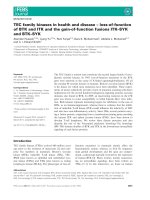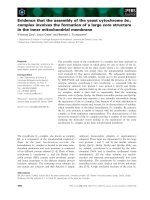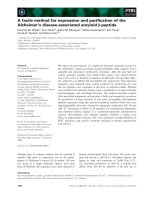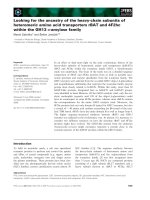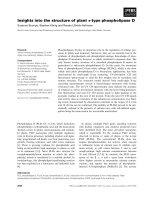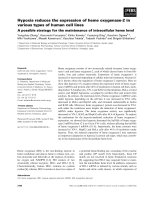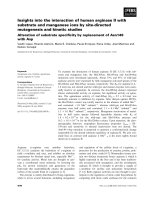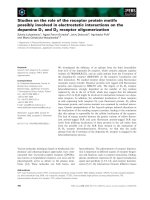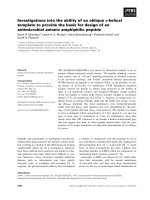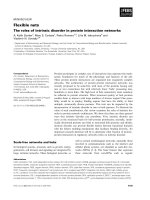Báo cáo sinh học : " Notch signaling, the segmentation clock, and the patterning of vertebrate somites" pptx
Bạn đang xem bản rút gọn của tài liệu. Xem và tải ngay bản đầy đủ của tài liệu tại đây (516.78 KB, 7 trang )
Review
NNoottcchh ssiiggnnaalliinngg,, tthhee sseeggmmeennttaattiioonn cclloocckk,, aanndd tthhee ppaatttteerrnniinngg ooff vveerrtteebbrraattee
ssoommiitteess
Julian Lewis, Anja Hanisch and Maxine Holder
Address: Vertebrate Development Laboratory, Cancer Research UK London Research Institute, 44 Lincoln’s Inn Fields, London WC2A 3PX, UK.
Correspondence: Julian Lewis. Email:
In one way or another, at one stage or another, almost every
tissue in an animal body depends for its patterning on the
Notch cell-cell signaling pathway [1]. The evidence from
mutants is clear: disrupted Notch signaling entails disrupted
pattern. The challenge is to define precisely what it is that
Notch signaling does in any given case, and when it does it.
This problem is posed in a particularly striking and curious
way by the phenomena of somitogenesis - the process by
which the vertebrate embryo lays down the regular
sequence of tissue blocks that will give rise to the musculo-
skeletal segments of the neck, trunk, and tail.
These blocks of embryonic tissue, the somites, are arranged
symmetrically in a neat, repetitive pattern on either side of
the central body axis. Each somite is separated from the next
by a cleft - the segment boundary; and each somite has a
definite polarity, with an anterior portion and posterior
portion expressing different sets of genes [2]. Mutations in
components of the Notch signaling pathway play havoc
with this whole pattern: although somites may eventually
form, the segment boundaries are irregular and randomly
positioned, and the regular antero-posterior polarity of
individual somites is lost. Genetic screens for mutations
that disrupt segmentation in this way chiefly identify Notch
pathway components as the critical players. Notch signaling
is clearly central to somitogenesis [3-6]. But precisely how?
NNoottcchh ppaatthhwwaayy ccoommppoonneennttss ccaann bbee wwiirreedd ttooggeetthheerr iinn
ddiiffffeerreenntt wwaayyss ffoorr ddiiffffeerreenntt oouuttccoommeess
In general, the function of the canonical Notch pathway is
to coordinate gene expression in contiguous cells. It does
this in a particularly direct way. The signal-sending cell
expresses a Notch ligand (belonging to either the Delta or
the Serrate/Jagged subfamily) on its surface; this binds to
the receptor, Notch, in the membrane of the signal-receiving
cell and thereby triggers cleavage of Notch, releasing an
intracellular fragment, the Notch intracellular domain
(NICD); NICD translocates to the nucleus, where it acts as a
transcriptional regulator [1,7] (Figure 1). The main - or at
least, the best-studied - targets of direct regulation by NICD
are the members of the Hairy/E(spl) family (Hes genes in
mammals, her genes in zebrafish) [8,9]; these code for
inhibitory basic helix-loop-helix (bHLH) transcriptional
AAbbssttrraacctt
The Notch signaling pathway has multifarious functions in the organization of the developing
vertebrate embryo. One of its most fundamental roles is in the emergence of the regular
pattern of somites that will give rise to the musculoskeletal structures of the trunk. The parts
it plays in the early operation of the segmentation clock and the later definition and
differentiation of the somites are beginning to be understood.
Journal of Biology
2009,
88::
44
Published: 22 May 2009
Journal of Biology
2009,
88::
44 (doi:10.1186/jbiol145)
The electronic version of this article is the complete one and can be
found online at />© 2009 BioMed Central Ltd
regulators, which can control many different secondary
targets, including Notch ligand genes and the Hes/her genes
themselves. The role of Notch signaling in pattern
formation depends on the ways in which these components -
and others that modulate their activity - are functionally
connected into regulatory feedback loops [10]. Mathe-
matical modeling highlights several possibilities. Thus, one
type of linkage, where Notch activation leads to down-
regulation of Notch ligand expression in the signal-receiving
cell, can lead to lateral inhibition, forcing neighboring cells
to become different from one another [11] (Figure 2). An
opposite linkage, whereby Notch activation stimulates
ligand expression, can have an opposite effect, inducing
contiguous cells to be similar [12]. Still other types of
circuitry built from the same components can perform yet
other tricks, including the production of temporal oscilla-
tions of gene expression [13,14]. And this brings us back to
somitogenesis, where such oscillations are in fact seen.
AA ggeennee eexxpprreessssiioonn oosscciillllaattoorr mmaarrkkss oouutt tthhee ppeerriiooddiicc
ppaatttteerrnn ooff bbooddyy sseeggmmeennttss
Somites derive from the unsegmented presomitic meso-
derm (PSM) at the tail end of the embryo. PSM cells are
specified by the combined action of Wnt and fibroblast
growth factor (FGF) signaling molecules, which are
produced at the tail end of the PSM and spread anteriorly to
generate a morphogen gradient. At the point where the level
of Wnt and FGF falls below a threshold value, somites form.
Thus, as the PSM grows caudally, extending the embryo,
one pair of somites after another is budded off from the
anterior end of the PSM in a regular head-to-tail sequence.
Each species generates its characteristic number of somites
at its own pace, ranging from one new somite pair approxi-
mately every 30 minutes in zebrafish to one pair every
2 hours in mice. This rhythmic process involves coordinated
patterns of cell behavior not only in space but also in time:
it depends on an underlying gene expression oscillator - the
segmentation clock - that ticks in the cells of the PSM and
dictates the rhythm of somite formation, with each
oscillator cycle corresponding to the production of one
additional somite [15]. The genes that were first found to
oscillate in the PSM and that show this cyclic expression in
all vertebrates belong to the Notch signaling pathway; these
oscillatory genes include, specifically, certain members of
the Hairy/E(spl) gene family of bHLH transcriptional
regulators - in particular Hes1 and Hes7 in mice, her1 and
her7 in zebrafish, and hairy1 and hairy2 in chick [15-22] -
and (in zebrafish) the Notch ligand DeltaC, whose
expression is controlled by them. These, and certain other
oscillatory genes, display a characteristic pattern of
expression that can be seen in fixed specimens stained by in
situ hybridization. In the posterior part of the PSM, the level
of expression may be high or low, depending on the phase
of the oscillation cycle at the moment when the embryo was
fixed. In the anterior part of the PSM, meanwhile, one sees a
stripy pattern, in which bands of cells that express the
oscillatory gene strongly alternate with bands of cells that
do not (Figure 3). This pattern reflects the gradual slowing
of the oscillations as cells approach the point of exit from
the PSM, beyond which oscillation is halted: cells in more
anterior positions are thus delayed in phase relative to more
44.2
Journal of Biology
2009, Volume 8, Article 44 Lewis
et al.
/>Journal of Biology
2009,
88::
44
FFiigguurree 11
Basic principles of Delta-Notch signaling. Notch is a cell-surface
receptor whose ligand Delta is also expressed on the cell surface.
Binding of Delta to Notch activates cleavage of Notch at the
membrane, thereby releasing the Notch intracellular domain (NICD),
which migrates to the nucleus where it functions in transcriptional
regulation. The detached extracellular fragment of Notch, NECD, along
with Delta, is endocytosed into the Delta-expressing cell.
Delta
Notch
Delta
NICD
NICD
NECD
NECD
V
Gene regulation
in nucleus
Cleavage
FFiigguurree 22
Lateral inhibition in differentiation. Two neighboring cells each express
both the Notch receptor and its ligand, Delta, but the cell on the left
expresses Delta more strongly, so that the
Hes/her
gene is activated in
the neighboring cell (on the right), and its product, an inhibitory
transcriptional regulator, acts in this cell to block expression both of
Delta and of genes for differentiation. Consequently, in the left-hand
cell Notch is not activated, the
Hes/her
gene is not transcribed, Delta
expression is maintained, and genes specifying differentiation are
expressed.
Hes/her gene
High Notch
signalling activity
Delta Notch
Delta
Notch
Hes/her gene
Differentiation
Low Notch
signalling activity
Differentiation
posterior cells, with the consequence that one sees laid out
along the antero-posterior axis of the PSM an ordered array
of cells in different phases of the oscillator cycle [15,23].
Disturbances of oscillator behavior are thus clearly displayed
in a disturbed spatial pattern of gene expression in the
anterior PSM - a great convenience for experimental analysis.
NNoottcchh ssiiggnnaalliinngg kkeeeeppss cceellll cclloocckkss ssyynncchhrroonniizzeedd
Since, as we noted earlier, any mutation that blocks Notch
signaling leads to disrupted somite segmentation, an
obvious suggestion is that the oscillation depends on Notch
signaling and fails to occur when Notch signaling fails.
However, the detailed consequences of mutations in the
Notch pathway do not quite fit this simple explanation. A
different interpretation is instead suggested by a closer
examination of the behavior of one of the oscillatory genes,
coding for the Notch ligand DeltaC, in zebrafish with
mutations in the Notch pathway [24]. The individual PSM
cells in these mutants still express DeltaC, but in an
uncoordinated way: tissue fixed for analysis by in situ
hybridization shows a pepper-and-salt mixture of cells
expressing DeltaC at different levels, as though the cells are
still oscillating individually, but no longer in synchrony
with their neighbors (Figure 4). Moreover, both in zebrafish
and in mice, the first few somites of embryos with Notch
pathway mutations develop almost normally [25-27],
implying that Notch signaling is not absolutely necessary
for somite segmentation and that the consequences of
failure of Notch signaling make themselves felt only
gradually, after the onset of somitogenesis. These findings
led to the suggestion that the primary function of Notch
signaling is not to drive the oscillations of individual cells,
but only to coordinate them and keep them synchronized;
and that the cells begin oscillation in synchrony at the start
of somitogenesis, and take several cycles to drift out of
synchrony when Notch signaling is defective [24]. This
proposal - that Notch signaling from cell to cell in the PSM
serves to maintain synchrony but is not necessary for
oscillation of individual cells - has been supported by
several subsequent experiments. For example, zebrafish
embryos can be treated at different stages of somitogenesis
/>Journal of Biology
2009, Volume 8, Article 44 Lewis
et al.
44.3
Journal of Biology
2009,
88::
44
FFiigguurree 33
Somitogenesis and the segmentation clock.
((aa))
The pattern of expression of one of the oscillatory genes -
deltaC
- during somitogenesis in the
zebrafish. Two specimens are shown, fixed and stained by
in situ
hybridization (ISH) at different phases of their somitogenesis cycle.
((bb))
Diagram
showing how the observed pattern of gene expression reflects the cyclic behavior of the individual cells. Each cell contains a gene-expression
oscillator - a clock - which slows down as the cell moves from the posterior to the anterior part of the PSM, giving rise to a pattern of stripes of
cells in different phases of their oscillation. The oscillation is halted as cells emerge from the PSM, leaving them arrested in different states (blue
versus white shading), thereby demarcating the somite boundaries (black lines). The extent of the PSM is defined by an Fgf + Wnt signal gradient,
with its origin at the tail end of the embryo.
Caudal growth
Individual cell clocks
in different phases
of the clock cycle
Anterior PSM
Oscillations slowing
Posterior PSM
Oscillations at
maximum speed
Formed somites
Oscillations halted
DeltaC ISH
phase B
DeltaC ISH
phase A
1/2 cycle
1 cycle
(a) (b)
with the inhibitor DAPT, which inhibits the enzyme that
releases NICD from the membrane (Figure 1) and thus
blocks Notch signal transmission. When Notch signaling is
prevented in this way, somite defects ensue, but always with
a delay that corresponds to a gradual disordering of the
pattern of oscillator gene expression [28,29]. Other
evidence comes from experiments where PSM cells are
transplanted into a wild-type zebrafish embryo from an
embryo in which the expression of the oscillatory her genes
is defective. The transplanted cells then cause abnormal
segmentation behavior in their neighbors; but they fail to
exert this effect if they are prevented from expressing the
Notch ligand DeltaC [30]. The oscillatory behavior of
individual PSM cells and the influence of Notch signaling
can also be demonstrated through study of cells from the
PSM of a transgenic mouse embryo containing a
luminescent Hes1 reporter. These cells show oscillating
expression of the reporter gene even when they are disso-
ciated and thus unable to communicate via Notch [31], but
in that condition the oscillations are much less regular than
in the intact tissue.
WWhhaatt iiss tthhee uullttiimmaattee ppaacceemmaakkeerr ooff tthhee sseeggmmeennttaattiioonn
cclloocckk??
All these findings support the view that Notch is needed to
maintain synchrony between the oscillations of the
individual cells, which are somewhat noisy and imperfect
timekeepers when left to their own devices. But what is
generating the cell-intrinsic oscillations? According to one
view, the core oscillator - the pacemaker of the whole
process - is a delayed negative feedback loop in the auto-
regulation of the oscillatory Hes/her genes - Hes7 in
mammals, her1 and her7 in the zebrafish [13,32] (Figure 5).
Loss of Hes7 in the mouse, or of her1 and her7 in the
zebrafish, disrupts segmentation all along the body axis;
and it has been shown experimentally that these genes are
indeed subject to negative regulation by their own products
[22,23,32,33]. The idea that this Hes/her negative feedback
loop is the core oscillator has been articulated in
quantitative mathematical terms and is supported by many
pieces of evidence, but it still lacks firm proof [34]. In
mouse and chick, the PSM cells also show oscillating
expression of various other genes, including (in the mouse)
genes in the Wnt and Fgf pathways [35-37], some of which
appear to continue their oscillation even when the Hes7
oscillations fail [35]. Thus, the nature of the ultimate
generator and pacemaker of the oscillations is still under
debate, especially for mouse and chick [38-40].
TThhee nneeeedd ffoorr NNoottcchh ssiiggnnaalliinngg mmaayy eexxtteenndd bbeeyyoonndd tthhee
ccoonnttrrooll ooff tthhee cclloocckk
Failure of synchronization is sufficient to explain the
disruption of segmentation in Notch pathway mutants. But
that is not necessarily the end of the story. To acknowledge
that Notch signaling has this critical function, and that that
is enough to explain the mutant phenotypes, is not the
same as saying that synchronization is the only function of
44.4
Journal of Biology
2009, Volume 8, Article 44 Lewis
et al.
/>Journal of Biology
2009,
88::
44
FFiigguurree 44
Disruption of somite patterning in a Notch mutant. When Notch
signaling fails, the individual cells (in zebrafish at least) continue to
oscillate but fall out of synchrony, and somite patterning breaks down.
Synchrony lost
Irregular somite
boundaries
FFiigguurree 55
Autoregulation of
Hes/her
genes. On activation, the
her1/7
gene
produces an inhibitory transcriptional regulator that acts to suppress
transcription of the
her1/7
gene itself, but only after a delay for
transcription (T
m
) and translation (T
p
). This can give rise to oscillations,
whose period is determined by the total delay in the feedback loop.
her1/7 gene
T
m
Delay
Delay
mRNA
Protein
T
p
Notch signaling in somitogenesis. At least two additional
functions have been proposed. One is in the final step at
which a segment boundary is created by physical separation
of one nascent somite from the next; the other is in creating
or maintaining the difference between anterior and
posterior halves of each somite. Each of these possible
further roles for Notch signaling - in boundary formation
and in segment polarity - seems attractive on the basis of
analogies with other systems. Thus, in the Drosophila wing
disc, Notch signaling plays a critical part in organizing the
dorso-ventral compartment boundary [41]; and in the
vertebrate hindbrain, likewise, it is involved in organizing
the boundaries between rhombomeres [42]. As for segment
polarity, the creation of a difference between the cells of the
anterior and posterior parts of each somite could be seen as
similar to the creation of differences between adjacent cells
through lateral inhibition - a well known function of Notch
signaling in many different systems [1].
NNoottcchh ssiiggnnaalliinngg iiss ddiissppeennssiibbllee ffoorr bboouunnddaarryy ffoorrmmaattiioonn
iinn zzeebbrraaffiisshh
It is in the anterior part of the PSM, where the oscillation of
cyclic genes slows down and then halts, that cells are assigned
to anterior or posterior somite compartments and clefts form,
finally demarcating one somite from the next. Thus, the
formation of the segment boundary and the specification of
antero-posterior polarity are both processes that occur
relatively late in the history of each somite, after its precursor
cells have graduated to the anterior part of the PSM from the
posterior as the embryo grows and extends. If the early
function of Notch signaling in maintaining synchrony in the
posterior PSM is disrupted, any failure in these later functions
is likely to be imperceptible amid the general chaos. One can,
however, test for the later functions by imposing a block of
Notch signaling part way through somitogenesis. For
example, one can take a zebrafish that has already formed
five somites and immerse it in a DAPT solution to block
Notch signaling from that time point onwards. The result is
striking: the next approximately 12 somites proceed to form
in the normal way, with regularly spaced boundaries, and
only after that does one begin to see segmentation defects
[28,29]. This shows that Notch signaling is not needed, in the
zebrafish at least, for the creation of somite boundaries, and
it quantitatively matches predictions based on the
proposition that the only function of Notch signaling is to
maintain synchrony in the posterior PSM [29].
CClleefftt ffoorrmmaattiioonn ccoorrrreellaatteess wwiitthh tthhee aappppeeaarraannccee ooff
sshhaarrpp bboouunnddaarriieess ooff ggeennee eexxpprreessssiioonn
Findings in the mouse, however, are not so clear, and there
are differing schools of thought. In a series of papers
[43-49], Saga and colleagues have argued that Notch
signaling is indeed needed to create a sharp boundary of
gene expression that is necessary to mark the future cleft
between one nascent somite and the next [43,44]. Their
conclusions emerge from study of a pair of transcriptional
regulators - Mesp2, and the less well characterized Mesp1 -
that are expressed in the anterior PSM. They seem to operate
as orchestrators of the process by which the output of the
somite oscillator is translated into the spatially repeating
pattern of the somites [45] - a process that is disrupted in
Mesp2 mutants [46]. Mesp2 is expressed dynamically in
each forming somite, beginning as a one-somite-wide stripe,
rapidly narrowing to a half-somite-wide stripe (which
marks the future anterior compartment of the somite), then
disappearing completely as the somite buds off from the
PSM. In the brief window during which it is expressed,
Mesp2 seems to be responsible for allocating anterior or
posterior identity to the cells of the somite through
activation or repression of various targets that distinguish
the anterior from the posterior cells, and for regulating
some of the genes required for border formation [47,48]. In
particular, somite boundaries form at interfaces where cells
with high expression of Mesp2 but low Notch activation
confront cells in an opposite state, with high Notch
activation but no expression of Mesp2. These observations
strongly suggest that some sort of feedback loop involving
Mesp2 and Notch signaling organizes the formation of an
interface between cells with high Notch activation and cells
with low Notch activation, and that this interface is
necessary to define the segment boundary. Moreover, the
same studies suggest that Notch signaling is involved in the
restriction of the Mesp2 expression domain from the whole
presumptive somite to just its anterior half [48,49], and
thus essential for the establishment of the anterior-posterior
polarity of each new somite. However, these observations
do not amount to firm proof: correlation need not imply
causation, and Mesp2, acting independently of Notch
activity, could be the critical factor. The pattern of Mesp2
expression is indeed altered in Notch pathway mutants
[43], but it is hard to be sure whether this reflects a function
of Notch signaling in the anterior PSM where Mesp2 is
expressed, or merely the aftermath of the disorder created
by prior failure of Notch signaling in the posterior PSM.
NNoottcchh ssiiggnnaalliinngg iiss rreeqquuiirreedd ttoo ggiivvee eeaacchh ssoommiittee iittss
aanntteerroo ppoosstteerriioorr ppoollaarriittyy
Feller et al. [50] tested the role of Notch signaling in the
mouse PSM in a different way and came to a somewhat
different view. When they artificially expressed NICD, the
intracellular transcriptional regulator domain of Notch,
throughout the entire PSM, they found that many somite
boundaries still formed, despite the absence of any interface
/>Journal of Biology
2009, Volume 8, Article 44 Lewis
et al.
44.5
Journal of Biology
2009,
88::
44
44.6
Journal of Biology
2009, Volume 8, Article 44 Lewis
et al.
/>Journal of Biology
2009,
88::
44
between cells with differing levels of Notch activation; these
boundaries, however, were irregularly spaced, and the
resulting irregular blocks of somite tissue lacked the normal
antero-posterior polarity. The same was seen when Notch
signaling, instead of being artificially activated, was in-
activated by mutations in Notch1, or Dll1 (Delta1), or Pofut1
(coding for an enzyme that fucosylates Notch and is
required for Notch function). In fact, a similar outcome is
seen in zebrafish Notch pathway mutants - clefts eventually
appear in the mesoderm, dividing it up into somites, but
these clefts form later than normal and are crooked and
irregularly spaced. The somitic mesoderm, it seems, has a
propensity to split up into tissue blocks and will do so even
if the segmentation clock is broken and Notch signaling
defective. The role of the clock is to control the pattern of
this splitting, ensuring that the clefts are regularly spaced,
and to confer on each somite a regular antero-posterior
polarity. For this last step, it seems that Notch signaling is
required directly and not merely to keep the segmentation
clocks of the individual cells ticking synchronously in the
run-up to overt segmentation; for in the mice where NICD
is expressed throughout the tissue, each somite has a
double-posterior character, whereas when Notch fails each
somite has a double-anterior character [50].
NNoottcchh ssiiggnnaalliinngg iiss uusseedd rreeppeeaatteeddllyy iinn tthhee ssoommiittee cceellll
lliinneeaaggee
The formation of the somites is not the end of the
involvement of Notch signaling in the development of the
somitic cell lineage. For example, skeletal muscle tissue,
which arises from the somites, also depends on this path-
way to control the differentiation of myoblasts and satellite
cells and their incorporation into multinucleate muscle
fibers [51-54]. Like that other ubiquitous communication
device, the mobile phone network, the Notch signaling
pathway has been recruited for many different purposes -
for the simple delivery of instructions from one individual
to another, for competitions and collaborations, for the
synchronization of individual actions, and for the playing
of the tunes to which cells dance.
RReeffeerreenncceess
1. Bray SJ:
NNoottcchh ssiiggnnaalliinngg:: aa ssiimmppllee ppaatthhwwaayy bbeeccoommeess ccoommpplleexx
Nat
Rev Mol Cell Biol
2006,
77::
678-689.
2. Hughes D, Keynes R, Tannahill D:
EExxtteennssiivvee mmoolleeccuullaarr ddiiffffeerr
eenncceess bbeettwweeeenn aanntteerriioorr aanndd ppoosstteerriioorr hhaallff sscclleerroottoommeess uunnddeerrlliiee
ssoommiittee ppoollaarriittyy aanndd ssppiinnaall nneerrvvee sseeggmmeennttaattiioonn
BMC Dev Biol
2009,
99::
30.
3. Gridley T:
TThhee lloonngg aanndd sshhoorrtt ooff iitt:: ssoommiittee ffoorrmmaattiioonn iinn mmiiccee
Dev
Dyn
2006,
223355::
2330-2336.
4. Holley SA:
TThhee ggeenneettiiccss aanndd eemmbbrryyoollooggyy ooff zzeebbrraaffiisshh mmeettaammeerriissmm
Dev Dyn
2007,
223366::
1422-1449.
5. Saga Y, Takeda H:
TThhee mmaakkiinngg ooff tthhee ssoommiittee:: mmoolleeccuullaarr eevveennttss iinn
vveerrtteebbrraattee sseeggmmeennttaattiioonn
Nat Rev Genet
2001,
22::
835-845.
6. Weinmaster G, Kintner C:
MMoodduullaattiioonn ooff nnoottcchh ssiiggnnaalliinngg dduurriinngg
ssoommiittooggeenneessiiss
Annu Rev Cell Dev Biol
2003,
1199::
367-395.
7. Kopan R, Ilagan MX:
TThhee ccaannoonniiccaall NNoottcchh ssiiggnnaalliinngg ppaatthhwwaayy::
uunnffoollddiinngg tthhee aaccttiivvaattiioonn mmeecchhaanniissmm
Cell
2009,
113377::
216-233.
8. Krejci A, Bernard F, Housden BE, Collins S, Bray SJ:
DDiirreecctt
rreessppoonnssee ttoo NNoottcchh aaccttiivvaattiioonn:: ssiiggnnaalliinngg ccrroossssttaallkk aanndd iinnccoohheerreenntt
llooggiicc
Sci Signal
2009,
22::
ra1.
9. Ong CT, Cheng HT, Chang LW, Ohtsuka T, Kageyama R, Stormo
GD, Kopan R:
TTaarrggeett sseelleeccttiivviittyy ooff vveerrtteebbrraattee nnoottcchh pprrootteeiinnss CCooll
llaabboorraattiioonn bbeettwweeeenn ddiissccrreettee ddoommaaiinnss aannd
d CCSSLL bbiinnddiinngg ssiittee aarrcchhii
tteeccttuurree ddeetteerrmmiinneess aaccttiivvaattiioonn pprroobbaabbiilliittyy
J Biol Chem
2006,
228811::
5106-5119.
10. Bray S:
NNoottcchh ssiiggnnaalliinngg iinn
DDrroossoopphhiillaa
:: tthhrreeee wwaayyss ttoo uussee aa
ppaatthhwwaayy
Semin Cell Dev Biol
1998,
99::
591-597.
11. Collier JR, Monk NA, Maini PK, Lewis JH:
PPaatttteerrnn ffoorrmmaattiioonn bbyy
llaatteerraall iinnhhiibbiittiioonn wwiitthh ffeeeeddbbaacckk:: aa mmaatthheemmaattiiccaall mmooddeell ooff ddeellttaa
nnoottcchh iin
ntteerrcceelllluullaarr ssiiggnnaalliinngg
J Theor Biol
1996,
118833::
429-446.
12. Lewis J:
NNoottcchh ssiiggnnaalliinngg aanndd tthhee ccoonnttrrooll ooff cceellll ffaattee cchhooiicceess iinn vveerr
tteebbrraatteess
Semin Cell Dev Biol
1998,
99::
583-589.
13. Lewis J:
AAuuttooiinnhhiibbiittiioonn wwiitthh ttrraannssccrriippttiioonnaall ddeellaayy:: aa ssiimmppllee mmeecchhaa
nniissmm ffoorr tthhee zzeebbrraaffiisshh ssoommiittooggeenneessi
iss oosscciillllaattoorr
Curr Biol
2003,
1133::
1398-1408.
14. Monk NAM:
OOsscciillllaattoorryy eexxpprreessssiioonn ooff HHeess11,, pp5533,, aanndd NNFF kkaappppaaBB
ddrriivveenn bbyy ttrraannssccrriippttiioonnaall ttiimmee ddeellaayyss
Curr Biol
2003,
1133::
1409-
1413.
15. Palmeirim I, Henrique D, Ish-Horowicz D, Pourquie O:
AAvviiaann hhaaiirryy
ggeennee eexxpprreessssiioonn iiddeennttiiffiieess aa mmoolleeccuullaarr cclloocckk lliinnkkeedd ttoo vveerrtteebbrraattee
sseeggmmeennttaattiioonn a
anndd ssoommiittooggeenneessiiss
Cell
1997,
9911::
639-648.
16. Bessho Y, Sakata R, Komatsu S, Shiota K, Yamada S, Kageyama R:
DDyynnaammiicc eexxpprreessssiioonn aanndd eesssseennttiiaall ffuunnccttiioonnss ooff HHeess77 iinn ssoommiittee sseegg
mmeennttaattiioonn
Genes Dev
2001,
1155::
2642-2647.
17. Gajewski M, Sieger D, Alt B, Leve C, Hans S, Wolff C, Rohr KB,
Tautz D:
AAnntteerriioorr aanndd ppoosstteerriioorr wwaavveess ooff ccyycclliicc hheerr11 ggeennee eexxpprreess
ssiioonn aarree ddiiffffeerreennttiiaallllyy rreegguullaatteedd i
inn tthhee pprreessoommiittiicc mmeessooddeerrmm ooff
zzeebbrraaffiisshh
Development
2003,
113300::
4269-4278.
18. Henry CA, Urban MK, Dill KK, Merlie JP, Page MF, Kimmel CB,
Amacher SL:
TTwwoo lliinnkkeedd hhaaiirryy//EEnnhhaanncceerr ooff sspplliitt rreellaatteedd zzeebbrraaffiisshh
ggeenneess,, hheerr11 aanndd hheerr77,, ffuunnccttiioonn ttooggeetthhe
err ttoo rreeffiinnee aalltteerrnnaattiinngg
ssoommiittee bboouunnddaarriieess
Development
2002,
112299::
3693-3704.
19. Holley SA, Geisler R, Nusslein-Volhard C:
CCoonnttrrooll ooff hheerr11 eexxpprreess
ssiioonn dduurriinngg zzeebbrraaffiisshh ssoommiittooggeenneessiiss bbyy aa DDeellttaa ddeeppeennddeenntt oosscciillllaa
tto
orr aanndd aann iinnddeeppeennddeenntt wwaavvee ffrroonntt aaccttiivviittyy
Genes Dev
2000,
1144::
1678-1690.
20. Holley SA, Julich D, Rauch GJ, Geisler R, Nusslein-Volhard C:
hheerr11
aanndd tthhee nnoottcchh ppaatthhwwaayy ffuunnccttiioonn wwiitthhiinn tthhee oosscciillllaattoorr mmeecchhaanniissmm
tthhaatt rreegguullaatteess zzeebbrraaffiisshh ssoommiittooggeenneessiiss
Development
2002,
112299::
1175-1183.
21. Jouve C, Palmeirim I, Henrique D, Beckers J, Gossler A, Ish-
Horowicz D, Pourquie O:
NNoottcchh ssiiggnnaalliinngg iiss rreeqquuiirreedd ffoorr ccyycclliicc
eexxpprreessssiioonn ooff tthhee hhaaiirryy lliikkee ggeennee HHEESS11 iinn tthhee pprreessoommiittiicc mmeessoo
ddeerrmm
Development
2000,
112277::
1421-1429.
22. Oates AC, Ho RK:
HHaaiirryy//EE((ssppll)) rreellaatteedd ((HHeerr)) ggeenneess aarree cceennttrraall
ccoommppoonneennttss ooff tthhee sseeggmmeennttaattiioonn oosscciillllaattoorr aanndd ddiissppllaayy rreedduunnddaannccyy
wwiitthh tthhee DDeellttaa//NNoottcchh ssiiggnnaalliinngg ppaatthhwwaayy iinn tthhee ffoorrmmaattiioonn ooff aannttee
rriioorr sseeggmmeennttaall bbo
ouunnddaarriieess iinn tthhee zzeebbrraaffiisshh
Development
2002,
112299::
2929-2946.
23. Giudicelli F, Ozbudak EM, Wright GJ, Lewis J:
SSeettttiinngg tthhee tteemmppoo iinn
ddeevveellooppmmeenntt:: aann iinnvveessttiiggaattiioonn ooff tthhee zzeebbrraaffiisshh ssoommiittee cclloocckk mmeecchhaa
nniissm
m
PLoS Biol
2007,
55::
e150.
24. Jiang YJ, Aerne BL, Smithers L, Haddon C, Ish-Horowicz D, Lewis
J:
NNoottcchh ssiiggnnaalliinngg aanndd tthhee ssyynncchhrroonniizzaattiioonn ooff tthhee ssoommiittee sseeggmmeennttaa
ttiioonn cclloocckk
Nature
2000,
440088::
475-479.
25. Conlon RA, Reaume AG, Rossant J:
NNoottcchh11 iiss rreeqquuiirreedd ffoorr tthhee
ccoooorrddiinnaattee sseeggmmeennttaattiioonn ooff ssoommiitteess
Development
1995,
112211::
1533-1545.
26. Huppert SS, Ilagan MX, De Strooper B, Kopan R:
AAnnaallyyssiiss ooff
NNoottcchh ffuunnccttiioonn iinn pprreessoommiittiicc mmeessooddeerrmm ssuuggggeessttss aa ggaammmmaa sseeccrree
ttaassee iinnddeeppeennddeenntt rroollee ffoorr pprreesseenniilliinnss iinn ssoommiittee ddiiffffeerreennttiiaattiioonn
Dev
Cell
2005,
88::
677-688.
27. van Eeden FJ, Granato M, Schach U, Brand M, Furutani-Seiki M,
Haffter P, Hammerschmidt M, Heisenberg CP, Jiang YJ, Kane DA,
Kelsh RN, Mullins MC, Odenthal J, Warga RM, Allende ML, Wein-
berg ES, Nüsslein-Volhard C:
MMuuttaattiioonnss aaffffeeccttiinngg ssoommiittee ffoorrmmaattiioonn
aanndd ppaatttteerrnniinngg iinn tthhee zzeebbrraaffiisshh,,
DDaanniioo rreerriioo
Development
1996,
112233::
153-164.
28. Riedel-Kruse IH, Muller C, Oates AC:
SSyynncchhrroonnyy ddyynnaammiiccss dduurriinngg
iinniittiiaattiioonn,, ffaaiilluurree,, aanndd rreessccuuee ooff tthhee sseeggmmeennttaattiioonn cclloocckk
Science
2007,
331177::
1911-1915.
29. Ozbudak EM, Lewis J:
NNoottcchh ssiiggnnaalliinngg ssyynncchhrroonniizzeess tthhee zzeebbrraaffiisshh
sseeggmmeennttaattiioonn cclloocckk bbuutt iiss nnoott nneeeeddeedd ttoo ccrreeaattee ssoommiittee bboouunnddaarriieess
PLoS Genet
2008,
44::
e15.
30. Horikawa K, Ishimatsu K, Yoshimoto E, Kondo S, Takeda H:
NNooiissee rreessiissttaanntt aanndd ssyynncchhrroonniizzeedd oosscciillllaattiioonn ooff tthhee sseeggmmeennttaattiioonn
cclloocckk
Nature
2006,
444411::
719-723.
31. Masamizu Y, Ohtsuka T, Takashima Y, Nagahara H, Takenaka Y,
Yoshikawa K, Okamura H, Kageyama R:
RReeaall ttiimmee iimmaaggiinngg ooff tthhee
ssoommiittee sseeggmmeennttaattiioonn cclloocckk:: rreevveellaattiioonn ooff uunnssttaabbllee oosscciillllaattoorrss iinn tthhee
iinnddiivviidduuaall pprreessoommiittiicc mmeessooddeerrmm cceellllss
Proc Natl Acad Sci USA
2006,
110033::
1313-1318.
32. Bessho Y, Hirata H, Masamizu Y, Kageyama R:
PPeerriiooddiicc rreepprreessssiioonn
bbyy tthhee bbHHLLHH ffaaccttoorr HHeess77 iiss aann eesssseennttiiaall mmeecchhaanniissmm ffoorr tthhee ssoommiittee
sseeggmmeennttaattiioonn cclloocckk
Genes Dev
2003,
1177::
1451-1456.
33. Hirata H, Bessho Y, Kokubu H, Masamizu Y, Yamada S, Lewis J,
Kageyama R:
IInnssttaabbiilliittyy ooff HHeess77 pprrootteeiinn iiss ccrruucciiaall ffoorr tthhee ssoommiittee
sseeggmmeennttaattiioonn cclloocckk
Nat Genet
2004,
3366::
750-754.
34. Lewis J, Ozbudak EM:
DDeecciipphheerriinngg tthhee ssoommiittee sseeggmmeennttaattiioonn cclloocckk::
bbeeyyoonndd mmuuttaannttss aanndd mmoorrpphhaannttss
Dev Dyn
2007,
223366::
1410-1415.
35. Aulehla A, Wehrle C, Brand-Saberi B, Kemler R, Gossler A,
Kanzler B, Herrmann BG:
WWnntt33aa ppllaayyss aa mmaajjoorr rroollee iinn tthhee sseeggmmeenn
ttaattiioonn cclloocckk ccoonnttrroolllliinngg ssoommiittooggeenneessiiss
Dev Cell
2003,
33::
395-406.
36. Dale JK, Malapert P, Chal J, Vilhais-Neto G, Maroto M, Johnson T,
Jayasinghe S, Trainor P, Herrmann B, Pourquie O:
OOsscciillllaattiioonnss ooff
tthhee ssnnaaiill ggeenneess iinn tthhee pprreessoommiittiicc mmeessooddeerrmm ccoooorrddiinnaattee sseeggmmeennttaall
ppaatttteerrnniinngg aanndd mmoorrpphhooggeenneessiiss iinn vveerrtteebbrraattee ssoommiittooggeenneessiiss
Dev
Cell
2006,
1100::
355-366.
37. Dequeant ML, Glynn E, Gaudenz K, Wahl M, Chen J, Mushegian A,
Pourquie O:
AA ccoommpplleexx oosscciillllaattiinngg nneettwwoorrkk ooff ssiiggnnaalliinngg ggeenneess uunnddeerr
lliieess tthhee mmoouussee sseeggmmeennttaattiioonn cclloocckk
Science
2006,
331144::
1595-1598.
38. Aulehla A, Wiegraebe W, Baubet V, Wahl MB, Deng C, Taketo M,
Lewandoski M, Pourquie O:
AA bbeettaa ccaatteenniinn ggrraaddiieenntt lliinnkkss tthhee cclloocckk
aanndd wwaavveeffrroonntt ssyysstteemmss iinn mmoouussee eemmbbrryyoo sseeggmmeennttaattiioonn
Nat Cell
Biol
2008,
1100::
186-193.
39. Giudicelli F, Lewis J:
TThhee vveerrtteebbrraattee sseeggmmeennttaattiioonn cclloocckk
Curr
Opin Genet Dev
2004,
1144::
407-414.
40. Ozbudak EM, Pourquie O:
TThhee vveerrtteebbrraattee sseeggmmeennttaattiioonn cclloocckk:: tthhee
ttiipp ooff tthhee iicceebbeerrgg
Curr Opin Genet Dev
2008,
1188::
317-323.
41. Irvine KD:
FFrriinnggee,, NNoottcchh,, aanndd mmaakkiinngg ddeevveellooppmmeennttaall bboouunnddaarriieess
Curr Opin Genet Dev
1999,
99::
434-441.
42. Cheng YC, Amoyel M, Qiu X, Jiang YJ, Xu Q, Wilkinson DG:
NNoottcchh aaccttiivvaattiioonn rreegguullaatteess tthhee sseeggrreeggaattiioonn aanndd ddiiffffeerreennttiiaattiioonn ooff
rrhhoommbboommeerree bboouunnddaarryy cceellllss iinn tthhee zzeebbrraaffiisshh hhiinnddbbrraaiinn
Dev Cell
2004,
66::
539-550.
43. Morimoto M, Takahashi Y, Endo M, Saga Y:
TThhee MMeesspp22 ttrraannssccrriipp
ttiioonn ffaaccttoorr eessttaabblliisshheess sseeggmmeennttaall bboorrddeerrss bbyy ssuupppprreessssiinngg NNoottcchh
aaccttiivviittyy
Nature
2005,
443355::
354-359.
44. Saga Y:
SSeeggmmeennttaall bboorrddeerr iiss ddeeffiinneedd bbyy tthhee kkeeyy ttrraannssccrriippttiioonn ffaaccttoorr
MMeesspp22,, bbyy mmeeaannss ooff tthhee ssuupppprreessssiioonn ooff nnoottcchh aaccttiivviittyy
Dev Dyn
2007,
223366::
1450-1455.
45. Oginuma M, Niwa Y, Chapman DL, Saga Y:
MMeesspp22 aanndd TTbbxx66 ccoooopp
eerraattiivveellyy ccrreeaattee ppeerriiooddiicc ppaatttteerrnnss ccoouupplleedd wwiitthh tthhee cclloocckk mmaacchhiinn
eerryy d
duurriinngg mmoouussee ssoommiittooggeenneessiiss
Development
2008,
113355::
2555-2562.
46. Saga Y, Hata N, Koseki H, Taketo MM:
MMeesspp22
:: aa nnoovveell mmoouussee ggeennee
eexxpprreesssseedd iinn tthhee pprreesseeggmmeenntteedd mmeessooddeerrmm aanndd eesssseennttiiaall ffoorr sseegg
mmeennttaattiioonn iinniittiiaatti
ioonn
Genes Dev
1997,
1111::
1827-1839.
47. Takahashi Y, Inoue T, Gossler A, Saga Y:
FFeeeeddbbaacckk llooooppss ccoommpprriiss
iinngg DDllll11,, DDllll33 aanndd MMeesspp22,, aanndd ddiiffffeerreennttiiaall iinnvvoollvveemmeenntt ooff PPsseenn11 aarree
ee
sssseennttiiaall ffoorr rroossttrrooccaauuddaall ppaatttteerrnniinngg ooff ssoommiitteess
Development
2003,
113300::
4259-4268.
48. Takahashi Y, Koizumi K, Takagi A, Kitajima S, Inoue T, Koseki H,
Saga Y:
MMeesspp22 iinniittiiaatteess ssoommiittee sseeggmmeennttaattiioonn tthhrroouugghh tthhee NNoottcchh
ssiiggnnaalliinngg ppaatthhwwaayy
Nat Genet
2000,
2255::
390-396.
49. Koizumi K, Nakajima M, Yuasa S, Saga Y, Sakai T, Kuriyama T, Shi-
rasawa T, Koseki H:
TThhee rroollee ooff pprreesseenniilliinn 11 dduurriinngg ssoommiittee sseegg
mmeennttaattiioonn
Development
2001,
112288::
1391-1402.
50. Feller J, Schneider A, Schuster-Gossler K, Gossler A:
NNoonnccyycclliicc
NNoottcchh aaccttiivviittyy iinn tthhee pprreessoommiittiicc mmeessooddeerrmm ddeemmoonnssttrraatteess uunnccoouu
pplliinngg ooff ssoommiittee ccoommppaarrttmmeennttaalliizzaattiioonn aanndd bboouunnddaarryy ffoorrmmaattiioonn
Genes Dev
2008,
2222::
2166-2171.
51. Conboy IM, Rando TA:
TThhee rreegguullaattiioonn ooff NNoottcchh ssiiggnnaalliinngg ccoonnttrroollss
ssaatteelllliittee cceellll aaccttiivvaattiioonn aanndd cceellll ffaattee ddeetteerrmmiinnaattiioonn iinn ppoossttnnaattaall
mmyyooggeenneessiiss
Dev Cell
2002,
33::
397-409.
52. Hirsinger E, Malapert P, Dubrulle J, Delfini MC, Duprez D, Hen-
rique D, Ish-Horowicz D, Pourquie O:
NNoottcchh ssiiggnnaalliinngg aaccttss iinn
ppoossttmmiittoottiicc aavviiaann mmyyooggeenniicc cceellllss ttoo ccoonnttrrooll MMyyooDD aaccttiivvaattiioonn
Development
2001,
112288::
107-116.
53. Schuster-Gossler K, Cordes R, Gossler A:
PPrreemmaattuurree mmyyooggeenniicc
ddiiffffeerreennttiiaattiioonn aanndd ddeepplleettiioonn ooff pprrooggeenniittoorr cceellllss ccaauussee sseevveerree
mmuussccllee hhyyppoottrroopphhyy iinn DDeellttaa11 mmuuttaannttss
Proc Natl Acad Sci USA
2007,
110044::
537-542.
54. Vasyutina E, Lenhard DC, Birchmeier C:
NNoottcchh ffuunnccttiioonn iinn mmyyooggee
nneessiiss
Cell Cycle
2007,
66::
1451-1454.
/>Journal of Biology
2009, Volume 8, Article 44 Lewis
et al.
44.7
Journal of Biology
2009,
88::
44
